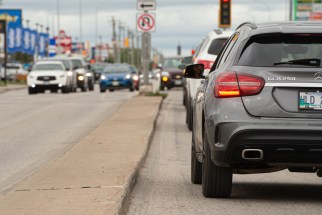A chance to redefine transportation
Read this article for free:
or
Already have an account? Log in here »
To continue reading, please subscribe:
Monthly Digital Subscription
$0 for the first 4 weeks*
- Enjoy unlimited reading on winnipegfreepress.com
- Read the E-Edition, our digital replica newspaper
- Access News Break, our award-winning app
- Play interactive puzzles
*No charge for 4 weeks then price increases to the regular rate of $19.00 plus GST every four weeks. Offer available to new and qualified returning subscribers only. Cancel any time.
Monthly Digital Subscription
$4.75/week*
- Enjoy unlimited reading on winnipegfreepress.com
- Read the E-Edition, our digital replica newspaper
- Access News Break, our award-winning app
- Play interactive puzzles
*Billed as $19 plus GST every four weeks. Cancel any time.
To continue reading, please subscribe:
Add Free Press access to your Brandon Sun subscription for only an additional
$1 for the first 4 weeks*
*Your next subscription payment will increase by $1.00 and you will be charged $16.99 plus GST for four weeks. After four weeks, your payment will increase to $23.99 plus GST every four weeks.
Read unlimited articles for free today:
or
Already have an account? Log in here »
Hey there, time traveller!
This article was published 29/11/2021 (1471 days ago), so information in it may no longer be current.
Over the next two weeks, the City of Winnipeg is looking for public feedback on Transportation Master Plan: 2050, a 30-year blueprint to guide development of Winnipeg’s transportation network.
In the past, transportation planning has focused primarily on strategies to move cars, but today it’s seen as a central tool for building healthy, sustainable and prosperous communities. Urban mobility is fundamental to economic viability, environmental sustainability and social equity, making Transportation Master Plan: 2050 a key document for the city.
The first step in developing a new transportation strategy will be to learn from the past and accept that current economic challenges, including Winnipeg’s $3 billion infrastructure deficit for roads and bridges, are largely the result of previous planning decisions.

We have spent decades building a city almost singularly focused on automobile transportation, resulting in a sprawling, low-density urban form that has become economically unsustainable. Despite record-breaking road maintenance spending, our current pace of renewal means new roads built today won’t be replaced for more than 100 years.
Nearly 10,000 more cars are added to Winnipeg’s streets every year, and in response we build more roads to accommodate them. This begins the endless cycle of induced demand. The convenience of expanded road capacity encourages more people to drive, increasing the number of cars on the road until the new capacity is met. This results in traffic congestion and pressure to build yet more roads.
Cities not being able to build their way out of traffic congestion has been a hard lesson to learn. Prioritizing vehicle transportation over other modes in Winnipeg has led to almost 15 per cent more people driving and 40 per cent fewer people using transit today, compared to the late 1980s.
After decades of designing North American cities around cars, it has become clear you get what you build for. If you build for more cars, you get more cars. Thankfully, induced demand works for all modes of transportation. If you build a more efficient public transit system, you get more people riding the bus. If you build a safe and connected network of sidewalks and bike lanes, you get more people walking and biking.

The relationships are direct and unwavering. Progressive transportation planning can use this to create multi-modal strategies that reduce spending on costly vehicle infrastructure while moving greater numbers of people.
A car-centric city is not only economically unsustainable, but also environmentally unsustainable. Vehicles account for almost half of Winnipeg’s greenhouse-gas emissions, by far the largest contributor. Transitioning to electric vehicles is important, but the climate crisis is far too immediate to rely on that approach exclusively. Strategies that allow people to drive less are much more effective at reducing environmental impact.
Winnipeg’s Climate Action Plan has set a target of doubling the number of trips taken by walking or biking by 2030.
To achieve this aggressive goal, Transportation Master Plan: 2050 will likely have to reconsider the Winnipeg Pedestrian and Cycling Strategy. Winnipeg’s cycling network has increased by 75 per cent since 2015, but the vast majority of this is suburban, off-street shared-use pathways, directed mainly at biking for recreation.
If we want people to use bikes for transportation, we must build protected lanes on higher traffic, main streets. Winnipeg’s plan calls for few larger streets to have cycling infrastructure, focusing instead on easier, low traffic, out-of-the-way residential streets.
This summer, Salter Street was rebuilt without bike lanes because the plan is to have a “greenway” on nearby Powers Street. If you have never heard of Powers Street, it’s because unless you live there, or know someone who does, you would never find yourself driving on that small residential street.
Salter Street has the destinations that people want to go to — shops, restaurants, schools, libraries — so the cycling infrastructure should be located there. This scenario is playing out across the city on such streets as Sargent Avenue, Corydon Avenue and Provencher Boulevard.
If we want to encourage people to use bikes as transportation, we must plan for it in the same way we plan for driving, with direct routes on major streets connected to the places people need to go, particularly in lower-income neighbourhoods where only nine per cent of the city’s cycling current infrastructure exists.
Strategies that allow people to drive less are much more effective at reducing environmental impact.
A renewed strategy for cycling infrastructure on main streets, dovetailed with Winnipeg Transit’s plan to implement a high-frequency transit model that will transform main streets into transit conduits, presents an important opportunity to redefine many of Winnipeg’s major arteries into complete streets.
A complete street is designed to safely support a broad range of mobility options, including walking, biking, transit and driving. A successful complete street supports transportation equity by providing a range of accessible mobility options that improve access to education, employment, and recreation for people of all ages, abilities, and income levels. As mobility hubs, complete streets attract a diversity of people, that can stimulate investment, new development and improve neighbourhood economies. They can create more livable communities, provide local employment opportunities and be catalysts for small business entrepreneurship.
Mobility has become a fundamental component of good city-building, and Transportation Master Plan: 2050 is an important opportunity to move Winnipeg in a new direction that makes our city more economically and environmentally sustainable, builds great communities and improves quality of life for everyone.
Brent Bellamy is senior design architect for Number Ten Architectural Group.

Brent Bellamy is senior design architect for Number Ten Architectural Group.
Our newsroom depends on a growing audience of readers to power our journalism. If you are not a paid reader, please consider becoming a subscriber.
Our newsroom depends on its audience of readers to power our journalism. Thank you for your support.
History
Updated on Monday, November 29, 2021 4:20 PM CST: Enhances formatting







